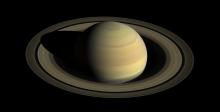Listen to today's episode of StarDate on the web the same day it airs in high-quality streaming audio without any extra ads or announcements. Choose a $8 one-month pass, or listen every day for a year for just $30.
You are here
Hanging Triangle
Summer is long gone, and winter’s just more than a week away. Yet one of the signature star patterns of summer is still in great view in the evening sky.
The Summer Triangle is well up in the west at nightfall. Its brightest point is the star Vega, about a third of the way up the sky. Deneb stands above it, with Altair well to the left of Vega.
Deneb represents the tail of Cygnus, the swan. At this time of year, the swan is nose-diving toward the horizon. In this position, the star pattern looks a lot like a crucifix, so it’s also known as the Northern Cross. It stands directly atop the horizon about 10 o’clock.
Every star and constellation has its own season. That’s because there’s a difference in the time it takes the Sun and the other stars to return to the same position in the sky.
The background stars — those we see at night — return to the same position every 23 hours and 56 minutes. But during that span, Earth moves a good distance in its orbit around the Sun. As a result, it takes four minutes longer for the Sun to return to the same position. The difference means that the distant stars all rise and set four minutes earlier each night, or two hours each month.
The Summer Triangle first appears at nightfall around the start of summer. Over the following months it climbs high overhead, then drops down the western sky in autumn and into early winter — a remnant of the warmer months of summer.
Script by Damond Benningfield





